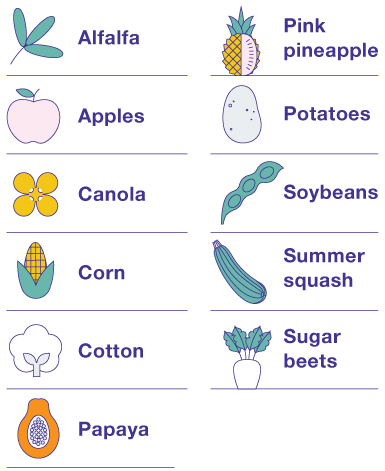A: There is good scientific consensus that GMO foods are safe and pose no threat to human health. The AAP’s recent report on GMOs was useful in some ways but presented a misleading, alarmist view of the risks posed by the weedkiller glyphosate, a view that conflicts with multiple health agencies.
In December, the American Academy of Pediatrics (AAP) released a report about foods that contain genetically modified organism (GMO) ingredients, intended to equip pediatricians to help families make healthy choices. The report was useful in some ways but was misleading in others and may fuel unwarranted panic.
What did the AAP report get right about GMO foods?
The AAP report was right to state that GMO foods – those created using genetic engineering – pose no unique hazard to human health. The AAP references a GMO safety review by the US National Academy of Sciences Engineering and Medicine, one of many organizations that have closely examined GMO safety over the last few decades (e.g. World Health Organization, Royal Society, Health Canada, European Food Safety Authority). These organizations all agree that foods made with GMO crops pose no more risk to human health than non-GMO foods. GMO foods have a long track record of safe use and are subject to a higher level of regulatory oversight and scientific requirements than traditional organisms consumed as food.
The report also highlights some confusing and misleading uses of the non-GMO label. For example, it’s common to see a non-GMO label on many foods for which no GMO version exists (e.g., non-GMO salt, bananas, oranges, raspberries, etc). In fact, you are unlikely to encounter GMOs in the produce section. The vast majority of GMOs are used to feed livestock or as ingredients for processed foods (e.g., sugar from GMO sugar beets, corn syrup from GMO corn, canola oil from GMO canola).

GMO foods in the U.S. (courtesy of the U.S. Food & Drug Administration)
The AAP correctly states that the best way to support our children’s health (and your own!) through food is by filling plates with wholesome, nutrient-rich foods. Worrying about GMOs is a distraction from focusing on what matters most.
What did the AAP report get wrong?
The AAP report went awry in its discussion of pesticides and health, especially regarding glyphosate, the world’s most widely used herbicide (weedkiller). First, they misrepresent the scientific consensus about the safety of glyphosate in our food supply. Second, they promote organic diets as a healthier choice for families, based on flawed data and reasoning.
Glyphosate is commonly used when growing a certain type of GMO crop called “Roundup Ready.” Roundup-ready crops (e.g., soy, corn, canola) are genetically modified to tolerate this herbicide. Farmers plant Roundup-ready crops because it simplifies weed management (they can kill nearby weeds without harming the crop), reduces use of more toxic pesticides, and reduces the need for environmentally harmful tilling.
The AAP report suggests that we should be concerned about glyphosate levels because: 1) the International Agency on Research for Cancer (IARC) rated glyphosate as a “potential carcinogen” and 2) glyphosate has been detected in many Americans’ urine samples.
This argument makes sense at first glance but is actually deeply flawed because it ignores the central tenet of toxicology: “the dose makes the poison.” Everything we consume can be harmful at extremely high doses, and everything also has a dose that is so low that it’s safe. For example, while 1-2 pills of Tylenol is safe, a whole bottle is not.
Levels of glyphosate and other pesticides are closely monitored by food safety regulators, with very reassuring results. The US Pesticide Monitoring Program and Health Canada consistently find that over 99% of foods are well below the safe limit. Furthermore, the levels of glyphosate that are detected in urine studies are consistent with exposures that are far below the safe limits. Detectable does not mean harmful!
In their report, the AAP report not only fails to put glyphosate levels in context but also presents a distorted view of the international consensus on the risks posed by glyphosate. It highlights the IARC’s determination that glyphosate is a “probable human carcinogen” (Group 2A). Yet it fails to mention that the IARC is an outlier – many other health and safety organizations, including the European Food Safety Authority, the US Environmental Protection Agency and Health Canada, have determined that glyphosate levels in our food supply do not pose a health hazard to consumers.
Why are different agencies reaching different conclusions? A big part of the answer is that the IARC assesses whether or not a substance is a hazard, whereas most other organizations assess whether or not something poses a risk (at a given exposure level). Unfortunately, the AAP report conflates hazard and risk.
A hazard is something that has the potential to harm you, while a risk is the likelihood of harm when exposed to a hazard. UV light is a hazard, but the resulting skin cancer risk depends on exposure: a few minutes a day in weak sunshine won’t move the needle on our skin cancer risk, while a few hours a day in peak sun could. Hazard determinations don’t tell the whole story because they ignore dose (exposure). Other hazards in the same category as glyphosate include extra hot beverages, red meat, working night shifts, and hairdressing.
We feel that it’s misleading of the AAP to present only the hazard-based view of glyphosate while ignoring the risk-based scientific consensus that glyphosate is safe for consumers at the levels in our food supply. Note: The level of risk for farmers who work directly with pesticides is less clear and warrants more studies and attention.
We hope that this post helped clear up any confusion that the American Academy of Pediatrics’ report may have caused. For a healthy diet, focus more on eating nutritious foods and less on GMOs and pesticides.
For more information, check out this post on GMO safety from Nerdy Girl Chana (our resident geneticist), this Intro to GMOs from SciMoms, and explore the resources below.
Resources
A good journal breaks bad: AAP spreads misinformation about glyphosate | Science-Based Medicine
Food, genetically modified | World Health Organization
Genetically modified (GM) plants: questions and answers | Royal Society
Agricultural Biotechnology | FDA
The safety of genetically modified (GM) foods – Canada.ca



